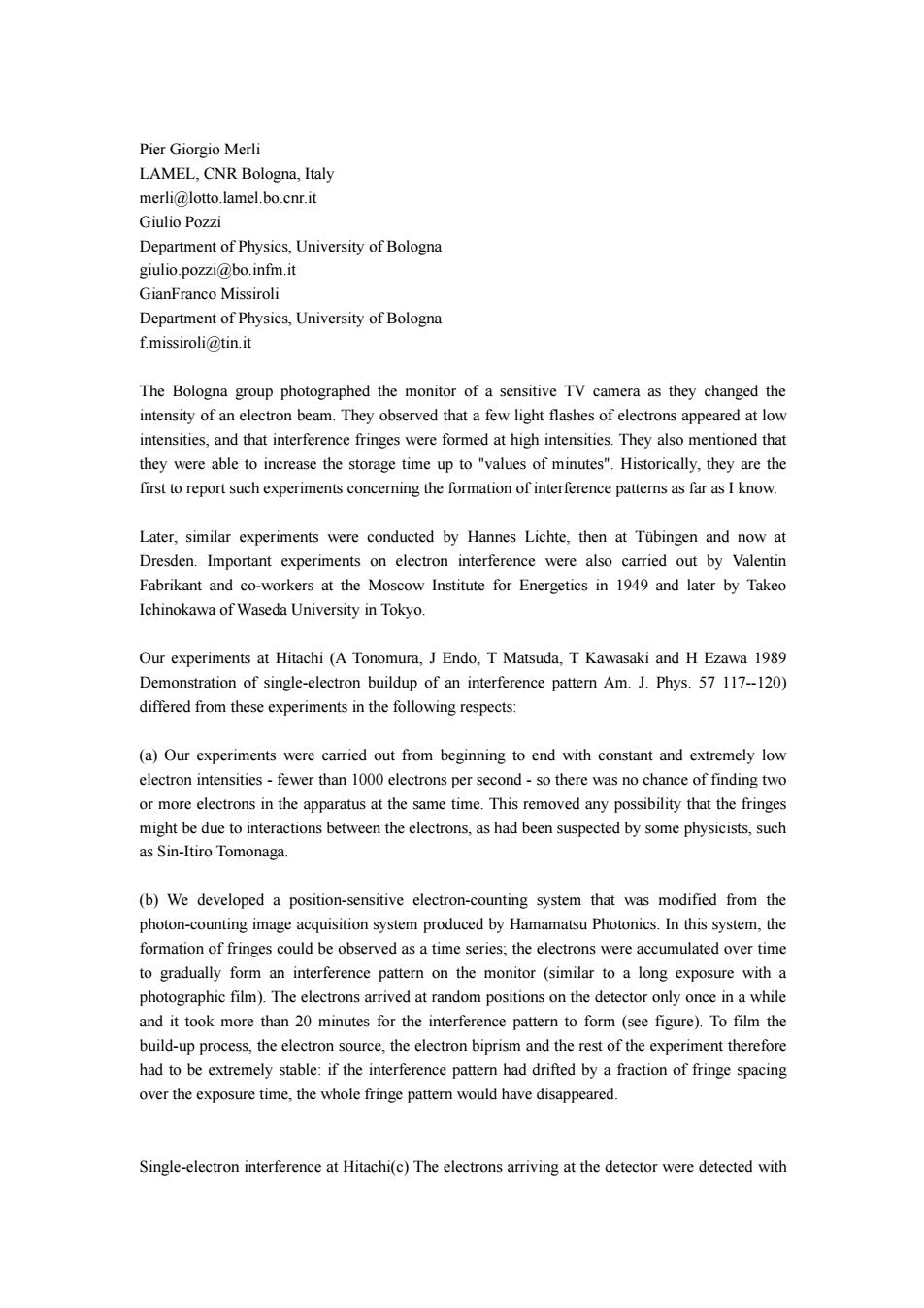正在加载图片...

Pier Giorgio Merli LAMEL,CNR Bologna,Italy merli@lotto.lamel.bo.cnr.it Giulio Pozzi Department of Physics,University of Bologna giulio.pozzi@bo.infm.it GianFranco Missiroli Department of Physics,University of Bologna f.missiroli@tin.it The Bologna group photographed the monitor of a sensitive TV camera as they changed the intensity of an electron beam.They observed that a few light flashes of electrons appeared at low intensities,and that interference fringes were formed at high intensities.They also mentioned that they were able to increase the storage time up to "values of minutes".Historically,they are the first to report such experiments concerning the formation of interference patterns as far as I know. Later,similar experiments were conducted by Hannes Lichte,then at Tubingen and now at Dresden.Important experiments on electron interference were also carried out by Valentin Fabrikant and co-workers at the Moscow Institute for Energetics in 1949 and later by Takeo Ichinokawa of Waseda University in Tokyo. Our experiments at Hitachi (A Tonomura,J Endo,T Matsuda,T Kawasaki and H Ezawa 1989 Demonstration of single-electron buildup of an interference pattern Am.J.Phys.57 117--120) differed from these experiments in the following respects: (a)Our experiments were carried out from beginning to end with constant and extremely low electron intensities-fewer than 1000 electrons per second-so there was no chance of finding two or more electrons in the apparatus at the same time.This removed any possibility that the fringes might be due to interactions between the electrons,as had been suspected by some physicists,such as Sin-Itiro Tomonaga. (b)We developed a position-sensitive electron-counting system that was modified from the photon-counting image acquisition system produced by Hamamatsu Photonics.In this system,the formation of fringes could be observed as a time series;the electrons were accumulated over time to gradually form an interference pattern on the monitor (similar to a long exposure with a photographic film).The electrons arrived at random positions on the detector only once in a while and it took more than 20 minutes for the interference pattern to form (see figure).To film the build-up process,the electron source,the electron biprism and the rest of the experiment therefore had to be extremely stable:if the interference pattern had drifted by a fraction of fringe spacing over the exposure time,the whole fringe pattern would have disappeared. Single-electron interference at Hitachi(c)The electrons arriving at the detector were detected withPier Giorgio Merli LAMEL, CNR Bologna, Italy merli@lotto.lamel.bo.cnr.it Giulio Pozzi Department of Physics, University of Bologna giulio.pozzi@bo.infm.it GianFranco Missiroli Department of Physics, University of Bologna f.missiroli@tin.it The Bologna group photographed the monitor of a sensitive TV camera as they changed the intensity of an electron beam. They observed that a few light flashes of electrons appeared at low intensities, and that interference fringes were formed at high intensities. They also mentioned that they were able to increase the storage time up to "values of minutes". Historically, they are the first to report such experiments concerning the formation of interference patterns as far as I know. Later, similar experiments were conducted by Hannes Lichte, then at Tübingen and now at Dresden. Important experiments on electron interference were also carried out by Valentin Fabrikant and co-workers at the Moscow Institute for Energetics in 1949 and later by Takeo Ichinokawa of Waseda University in Tokyo. Our experiments at Hitachi (A Tonomura, J Endo, T Matsuda, T Kawasaki and H Ezawa 1989 Demonstration of single-electron buildup of an interference pattern Am. J. Phys. 57 117--120) differed from these experiments in the following respects: (a) Our experiments were carried out from beginning to end with constant and extremely low electron intensities - fewer than 1000 electrons per second - so there was no chance of finding two or more electrons in the apparatus at the same time. This removed any possibility that the fringes might be due to interactions between the electrons, as had been suspected by some physicists, such as Sin-Itiro Tomonaga. (b) We developed a position-sensitive electron-counting system that was modified from the photon-counting image acquisition system produced by Hamamatsu Photonics. In this system, the formation of fringes could be observed as a time series; the electrons were accumulated over time to gradually form an interference pattern on the monitor (similar to a long exposure with a photographic film). The electrons arrived at random positions on the detector only once in a while and it took more than 20 minutes for the interference pattern to form (see figure). To film the build-up process, the electron source, the electron biprism and the rest of the experiment therefore had to be extremely stable: if the interference pattern had drifted by a fraction of fringe spacing over the exposure time, the whole fringe pattern would have disappeared. Single-electron interference at Hitachi(c) The electrons arriving at the detector were detected with